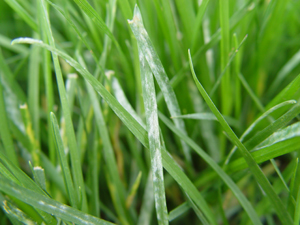G1911
Powdery Mildew Disease in Turfgrass
Causes, symptoms and management of powdery mildew disease in turfgrass. This is one in a series of NebGuides on managing turfgrass diseases.
Loren J. Giesler, Extension Plant Pathologist
- Introduction
- Cause, Hosts, and Occurrence
- Key Symptoms
- Recommended Cultural/Maintenance Practices
- Fungicide Program
|
Introduction
Powdery mildew occurs in shady areas of turfgrass. It can be effectively managed by seeding with shade-tolerant grass or by manipulating landscaping so that turf can be in full sun. If these changes aren’t possible, fungicides are available for managing this disease. The following information describes the disease and how to identify and manage it.
Cause, Hosts, and Occurrence
Cause: Erysiphe graminis
Primary hosts: Kentucky bluegrass
Occurrence: May – June, August – October
Key Symptoms
- Grayish white cast to the turf.
- Individual leaf blades look as though they were dusted with flour or lime (Figure 1).
Recommended Cultural/Maintenance Practices
- Prune shade trees to increase light penetration to the turf area.
- Remove or thin surrounding vegetation to improve air movement and lower humidity in the grass canopy.
- Reseed shaded areas with a mixture of mildew-resistant, improved Kentucky bluegrass cultivars and shade-tolerant, fine-leaved fescues.
- Fungicides (Table I) can be used to manage this disease in high maintenance turf areas. Applications must begin prior to significant mildew development.
Fungicide Program
Fungicides for powdery mildew are presented in Table I. An example product is listed for each active ingredient; other products also may be available. Homeowner and commercial product labels will list active ingredients. While the active ingredient may be in combination with others, users should look for a specific active ingredient with or without other chemistry modes of action.
| Table I. Fungicides for powdery mildew control in turf1 | ||||
| Fungicide | Fungicide Class | Application Interval (days) |
Efficacy2 |
Product |
| Copper hydroxide + mancozeb | Inorganic + dithiocarbamate | 7-14 |
L |
Junction |
| Fenarimol | DMI4 | 1x |
L |
Rubigan |
| Myclobutanil | DMI | 14-28 |
4 |
Eagle |
| Propiconazole | DMI | 14-28 |
4 |
Banner MAXX3 |
| Triadimefon | DMI | 15-30 |
4 |
Bayleton |
1Fungicide active ingredients, class and efficacy ratings for products labeled for the control of powdery mildew. Table adapted from: Chemical Control of Turfgrass Diseases 2008, P. Vincelli and A.J. Powell, University of Kentucky Cooperative Extension Service. |
||||
This publication has been peer reviewed.
Disclaimer Fungicides listed represent the best information available. No criticism is intended of products not listed, nor is endorsement by the University of Nebraska–Lincoln given to those listed. Read and follow all product label directions for mixing and application. |
Visit the University of Nebraska–Lincoln Extension Publications Web site for more publications.
Index: Plant Diseases
Turf
Issued February 2009
